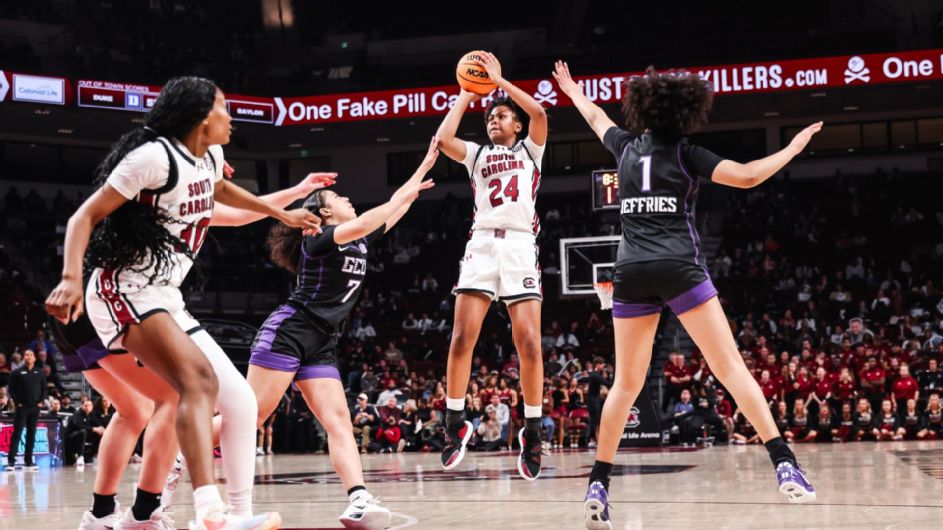Sports
Five Questions That Will Shape the 2026 Women’s NCAA Tournament

The 2025-26 women’s college basketball season commenced on Monday, marking a pivotal moment for teams as they begin their journey toward the NCAA tournament. Unlike the previous year, which experienced significant upheaval due to conference realignment, this offseason has been relatively calm. With the season underway, attention shifts to crucial questions that could influence the tournament landscape leading up to Selection Sunday on March 15, 2026.
The Big Ten’s Nonconference Performance
The Big Ten Conference is poised to make history with 13 teams projected to qualify for the NCAA tournament, surpassing the record of 12 teams set last season. Notably, four of these teams—Nebraska, Oregon, Illinois, and Minnesota—are currently seeded 9 or lower, meaning securing 13 spots is not guaranteed.
The performance of Big Ten teams during November and December will be crucial. A strong showing in nonconference play could enhance the individual profiles of these teams, positively influencing their NET rankings. For instance, a potential victory for Michigan over Notre Dame or UConn would bolster their credentials, making any subsequent wins against them more impressive. The depth of the Big Ten will be tested, and how it translates into NCAA tournament bids will unfold over the next two months.
South Carolina’s Adjustments Without Key Players
The South Carolina Gamecocks face a significant challenge following the season-ending knee injury of Chloe Kitts. This loss impacts not only the starting lineup but also the team’s overall depth. Coach Dawn Staley has opted for a three-guard lineup featuring Ta’Niya Latson, Tessa Johnson, and Raven Johnson, with Joyce Edwards and Madina Okot providing necessary size.
Despite the formidable starting five, the bench lacks experience, with reserves Maryam Dauda and Adhel Tac having averaged only 10.2 minutes per game last season. For South Carolina to remain a top contender and secure a No. 1 seed, players like Okot must step up to fill the void left by Kitts, who averaged 10.2 points and 7.7 rebounds per game. Latson’s leadership, as demonstrated by her 20-point performance in the season opener, will be vital as the team navigates this transition.
USC’s Uncertain Future Without Watkins
The University of Southern California (USC) is confronting a season filled with uncertainty as they adjust to life without JuJu Watkins, who is sidelined for the entire year due to a knee injury. Additionally, six of the seven players from last season’s rotation are also unavailable, leaving sophomore Kennedy Smith as the only returning player who averaged more than 13 minutes per game.
Despite the challenges, USC has welcomed talented transfers Kara Dunn and Londynn Jones, along with promising freshman Jazzy Davidson. This influx of new talent makes USC one of the more enigmatic teams in the AP Top 25. Their performance could swing in either direction: they may contend at the top of the Big Ten or struggle to secure a spot in the tournament.
Impact of the SEC on Tournament Seedings
The Southeastern Conference (SEC) is recognized for its depth and talent, with five teams from the league projected to land in the top two seed lines for the NCAA tournament. South Carolina and Texas are currently positioned as No. 1 seeds, underlining the conference’s strength.
As the season progresses, the standings within the SEC will be crucial. A matchup between Oklahoma and Tennessee, both projected as No. 2 seeds, could significantly impact the rankings. The Gamecocks are scheduled to visit Oklahoma on January 22, while Tennessee will host Texas on February 15. Outcomes of these games could tighten the competition for top seeds but would not severely dent the resumes of South Carolina or Texas if they were to lose.
Emerging Mid-Major Candidates for At-Large Bids
As the tournament approaches, the potential for mid-major teams to secure at-large bids remains a topic of interest. The Ivy League, having produced multiple tournament bids in recent years, looks promising with teams like Princeton and Columbia eyeing spots. Both teams will need to secure top standings in the league and aim for a strong showing in the Ivy Madness finals.
In the Missouri Valley Conference, Murray State and Belmont are in contention for multiple bids. Belmont has a challenging nonconference schedule, facing teams like Tennessee, Kentucky, Princeton, and Duke. A victory against any of these opponents could bolster their chances, while a successful conference tournament run could see both teams make history by qualifying for the NCAA tournament together for the first time since 2021.
As the season unfolds, these questions will shape the narrative of the women’s NCAA tournament and determine the fates of countless teams across the nation. With the first updates of Bracketology set to begin this week, fans and analysts alike will be closely monitoring how these dynamics play out on the court.
-

 Health2 months ago
Health2 months agoNeurologist Warns Excessive Use of Supplements Can Harm Brain
-

 Health2 months ago
Health2 months agoFiona Phillips’ Husband Shares Heartfelt Update on Her Alzheimer’s Journey
-

 Science2 weeks ago
Science2 weeks agoBrian Cox Addresses Claims of Alien Probe in 3I/ATLAS Discovery
-

 Science2 weeks ago
Science2 weeks agoNASA Investigates Unusual Comet 3I/ATLAS; New Findings Emerge
-

 Science2 weeks ago
Science2 weeks agoScientists Examine 3I/ATLAS: Alien Artifact or Cosmic Oddity?
-

 Entertainment4 months ago
Entertainment4 months agoKerry Katona Discusses Future Baby Plans and Brian McFadden’s Wedding
-

 Science1 week ago
Science1 week agoNASA Investigates Speedy Object 3I/ATLAS, Sparking Speculation
-

 World2 months ago
World2 months agoCole Palmer’s Cryptic Message to Kobbie Mainoo Following Loan Talks
-

 Entertainment3 months ago
Entertainment3 months agoEmmerdale Faces Tension as Dylan and April’s Lives Hang in the Balance
-

 Science1 week ago
Science1 week agoNASA Scientists Explore Origins of 3I/ATLAS, a Fast-Moving Visitor
-

 Entertainment4 months ago
Entertainment4 months agoLove Island Star Toni Laite’s Mother Expresses Disappointment Over Coupling Decision
-

 Entertainment2 months ago
Entertainment2 months agoMajor Cast Changes at Coronation Street: Exits and Returns in 2025









